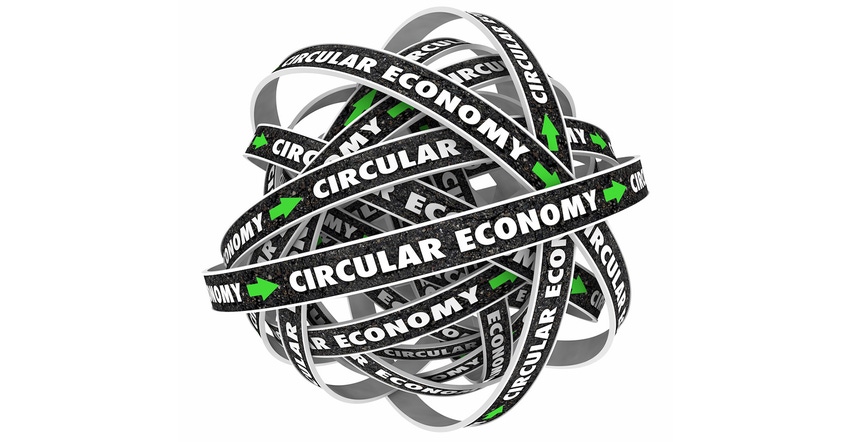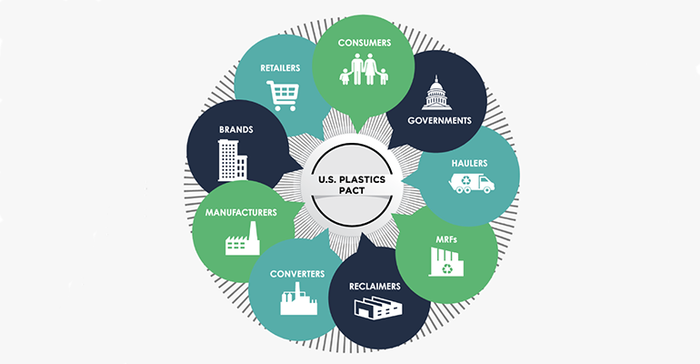Aggressive “Roadmap to 2025” refocuses on proactive efforts to boost plastics recycling and to accelerate the transition to a circular economy for plastics.

Launched in August 2020, the The U.S. Plastics Pact is a consortium led by The Recycling Partnership and World Wildlife Fund (WWF) as part of the Ellen MacArthur Foundation’s global Plastics Pact network, which unites a holistic ecosystem of cross-industry stakeholders behind a common vision and national strategy to address plastic waste at its source by 2025. Dozens of stakeholders known as U.S. Pact Activators are involved.
On June 15 the U.S. Plastics Pact released a new and aggressive “Roadmap to 2025” it believes will help reduce plastic waste in the environment and create a circular economy for plastics in the United States by 2025. It’s supported by nearly 100 corporations, start-ups, research entities, NGOs, universities, and state and local governments across the plastics packaging value chain and includes mandatory reporting and specific timeframes in order to realize meaningful and targeted outcomes for a circular economy for plastics.
The Roadmap’s goals:
Define a list of packaging to be designated as problematic or unnecessary by 2021 and take measures to eliminate them by 2025.
100% of plastic packaging will be reusable, recyclable, or compostable by 2025.
By 2025, undertake ambitious actions to effectively recycle or compost 50% of plastic packaging.
By 2025, the average recycled content or responsibly sourced bio-based content in plastic packaging will be 30%.
The U.S. Pact Roadmap is designed to advance these goals and measure progress through annual reporting. As well, it is considered a “living” document that can be adjusted.
“The current state of U.S. infrastructure, coupled with the lack of incentives to utilize recycled content in plastic packaging, have put immense strain on the value chain,” says Emily Tipaldo, Executive Director, The U.S. Plastics Pact. “The Roadmap is designed to help U.S. industry leaders act on the significant, systemwide change needed to realize a circular economy for plastics by 2025. The timeframe is short, and the workload is immense, but if we choose to do nothing, the visions of a circular economy across the US will give way to the status quo. We look forward to working with all our Activators to drive this critical change.”

One of the Pact’s Activators is the National Association for PET Container Resources. NAPCOR tracks and reports on the recovery of PET bottles in its annual PET Recycling Report, which has hovered around 30% for the past decade.
“PET has performance properties that not only make it an excellent material for bottles and containers, but lends itself to being recycled over and over again,” states Darrel Collier, NAPCOR Executive Director. “The U.S. Plastics Pact recycling goal of 50% is ambitious, but not impossible. Globally, PET has a recycling rate in excess of 50%. To achieve the ambitious recycling goal here in the US, it is imperative that we think differently about collection, including embracing well designed incentivized collection programs.”
Other stakeholders’ responses.
Here’s what other stakeholders from suppliers to brands and others are saying:
“To meaningfully address the plastic waste crisis in the United States, we must unite the critical stakeholders — industry leaders, waste management systems, and policymakers — under a cohesive action plan. The Roadmap will be the key for setting a national strategy that reaches our set targets and measures our progress in a consistent, transparent manner.” — Erin Simon, Head, Plastic Waste and Business at World Wildlife Fund
“Amcor is committed to creating responsible packaging that is recycled and reused. Our innovation is designing more and more of our packaging to be recycled and using more recycled content, but we need progress on infrastructure and consumer participation too. That is why we are proud to support the rollout of the U.S. Plastics Pact Roadmap – which shows how cooperation across the value chain can help us solve the problem of waste in the environment.” — David Clark, Amcor VP of Sustainability
"Eliminating waste from our packaging is a top priority for Clorox. We also recognize that to accelerate our collective efforts toward a world without plastic waste, we need stakeholders across the value chain to collaborate, and U.S. Pact's Roadmap is a blueprint for making that happen. When the Roadmap succeeds, we succeed. Clorox is motivated to help turn this vision into reality." — Ed Huber, Chief Sustainability Officer, The Clorox Co.
“The Roadmap is an important step toward igniting systems change for the circularity of packaging in the US. The Recycling Partnership is proud to be leading the way as we engage stakeholders from all along the full supply chain in creating scalable solutions that are tailor made to fit the unique needs of our US.system.” — Sarah Dearman, VP of Circular Ventures, The Recycling Partnership
ACC asks: what about Advanced Recycling?
“We welcome the goals of the U.S. Plastics Pact’s Roadmap to 2025, a plan to further ‘kickstart action’ on plastics recycling in the United States,” says Joshua Baca, the American Chemistry Council’s vice president of plastics. “We strongly share in the vision of a circular economy for plastics, and we look forward to opportunities to work with those involved.
“In 2018, America’s Plastics Makers established two critical goals: 100% of U.S. plastic packaging is recyclable or recoverable by 2030 and 100% of U.S. plastic packaging is re-used, recycled or recovered by 2040. Last year, we released our own Roadmap to Reuse, which outlined a vision to mobilize the entire plastics value chain to achieve these goals.
“Absent from the U.S. Plastic Pact’s roadmap is a recognition of the role that advanced recycling will play in ensuring more types of plastics are recycled and used again and again,” says Baca. “Breakthroughs in advanced recycling enable us to reduce waste by capturing the post-use value of notable plastics, like multilayer pouches and film, mixed plastics and polystyrene foam food containers. And today’s advanced recycling technologies enable food, medical and pharmaceutical grade plastics to be produced from used plastics.
“As an industry, our hope is the Pact will focus more on proactive efforts to boost plastics recycling and to mature the circular economy for plastics.
“We also call for the Pact to be transparent, data-driven and make recommendations based on science and engineering, rather than ideology, when it comes to efforts to ‘phase out problematic plastic’. Having an inclusive and open process will generate more informed and reliable outcomes and minimize risks of unintended consequences that can result from material substitution.
“Elimination of certain types of plastics or bans do not increase plastics recycling,” Baca continues. “Hurriedly choosing winners and losers today also ignores the essential role plastic packaging plays in reducing greenhouse gas emissions compared to other materials.
“As noted, the Pact’s ‘Roadmap is a living document and will evolve’. We hope part of this evolution will be continued dialogue to ensure a clear path to recycle all types of plastics.”
About the Author(s)
You May Also Like




